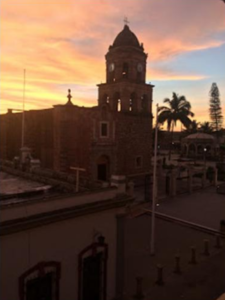Real Mexico (Compostela Clinic February 3—February 11, 2018)
The plane landed in Puerto Vallaita Mexico in the early afternoon and by evening we, 20 some volunteers , arrived in a town of 16,000 towards the middle of the Mexican state of Nayarit. Compostela up in the hills and away from the coast, has little or no tourism, is not widely known, and because of that is unlike the country most who visit Mexico experience. They aie not intent on selling you espresso coffee, jewelry, vegetarian food, tattoos, or trinkets like they do on Mexico’s beaches. In Compostela they’re busy growing sorghum and mangos, tobacco and com, beans, and raising horses and cows, along with children.
We checked into an old hotel on the square and were taken to our clinic site, a building normally used as a community health center for diabetics on the edge of town. It was small but clean. We had to quickly figure out how to set up. We decided registration needed to be done outside. Not ideal, but necessary’. Even with that space would be tight. There would still be little room for patients waiting at different points in the clinic once they entered. The next day our hosts would move a canopy near the entrance to provide shade to those forced to wait outside.
We set up our stations: registration, nurse, visual acuity, auto refractor, eye doctors (4), and finally dispensing where people receive glasses if needed. We unpacked and spread out our catalogue of 7,000 pairs of used eye glasses from Lion’s Club warehouses in California and Illinois, and kind people we know who save them for us. By 8:00 p.m. we were more or less ready for Sunday, the first day of a four day clinic. Super Bowl Sunday by the way. That first day of travel and set up is always a long one.
My wife and I were on the third floor of the small hotel, directly across from the town’s central plaza and bell tower of its largest Catholic Church, San Santiago Apostai. It was designed by the Spanish in 1540 and built by the hands of local Mexicans. It remains a vital working parish 478 years later. People of all ages cross themselves when they pass by.
 We arrived at the clinic about 7:30, hoping to open the doors by 8:00. People were there when we arrived, holding little squares of paper, their pre-enrollment ticket for glasses on Sunday. Our hosts, the local Rotary club, were very well organized.
We arrived at the clinic about 7:30, hoping to open the doors by 8:00. People were there when we arrived, holding little squares of paper, their pre-enrollment ticket for glasses on Sunday. Our hosts, the local Rotary club, were very well organized.
They had been with us every step of the way. They were at their airport ready to run interference to get our glasses and equipment through customs, at the coach bus which they hired offering beer, soda and homemade tacos on the ride up into the mountains, at the hotel helping us register and get to our rooms, at the clinic with sandwiches helping us set up that evening.
The real story of tírese clinics is the people we serve and the local people who help us provide that service. Let’s start with the latter. They were Rotary Club members, business owners, Mexicans with means. Who else has the capacity to fund and carry out a community project like this? One of the main organizers was a local family practice doctor, a dynamic young woman who took charge of the front door, got us whatever we needed, and stayed from the time the first patient came through the door till the last one left.

